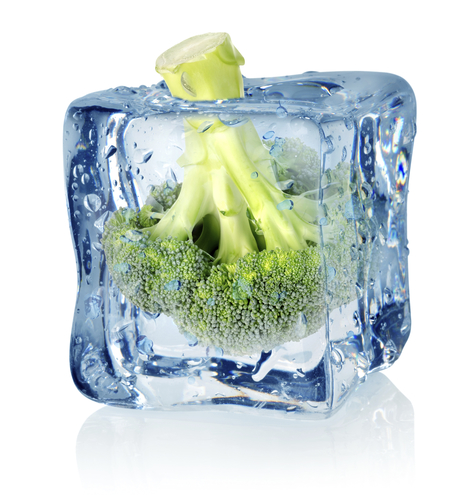Cold facts

Few other sectors rely on refrigeration and freezing more than the food and beverage industry. It is an often ignored essential so it is good to see some research into ice crystal-size minimisation plus some warnings about counterfeit and mis-labelled refrigerants appearing as R-22 is phasing out.
Better refrigeration techniques on the horizon
The ice crystals that form when water freezes can damage cells and tissues resulting in a loss of texture when food is thawed. In the food industry flash freezing partially overcomes this problem by limiting the size of the ice crystals that can form.
Ice crystals also cause problems when preserving biological and medical samples. Cryopreservation has already found widespread use for preserving semen, blood, embryos and plant seeds but scientists would like to be able to preserve tissues and even organs for later use. A new approach to freezing that will limit ice crystal-caused cellular damage is being explored by researchers at the College of Engineering at Oregon State University. Their ‘vitrification’ or ice-free cryopreservation system could ultimately allow a much wider use of extreme cold to preserve tissues.
Previously researchers have used various types of cryoprotectants that help reduce cell damage during the freezing process — among them is ethylene glycol, literally the same compound often used in automobile radiators to prevent freezing. However, many of these cryoprotectants are toxic and can damage or kill the very cells they are trying to protect from the forces of extreme cold.
In the new OSU research, the engineers developed a mathematical model to simulate the freezing process in the presence of cryoprotectants and identified a way to minimise damage. They found that if cells are initially exposed to a low concentration of cryoprotectant and time is allowed for the cells to swell, then the sample can be vitrified after rapidly adding a high concentration of cryoprotectants. The end result is much less overall toxicity.
The research showed that healthy cell survival following vitrification rose from about 10% with a conventional approach to more than 80% with the new optimised procedure.
“The biggest single problem and limiting factor in vitrification is cryoprotectant toxicity, and this helps to address that,” Higgins said. “The model should also help us identify less toxic cryoprotectants, and ultimately open the door to vitrification of more complex tissues and perhaps complete organs.”
There is not a lot of scope for this technique in the food processing industry yet but it is good to see research into refrigeration and its effects on cellular structure.
Phasing out refrigerant R-22
Wilhelmsen Ships Service, a leading global provider of services and products to the shipping industry, is warning of price, supply and safety risks in the run-up to the global ban on R-22 (chlorodifluoromethane or HCFC) refrigerant. The colourless gas, which has high ozone depletion and global warming potential, is still said to be in use on between 6000 and 8000 vessels worldwide.
R-22 was outlawed throughout the EU in a process that ran from 2010 to 1 January 2015. It is currently being phased out in the US, where no new or imported R-22 will be permitted from 1 January 2020. As part of the Montreal Protocol (MP), a UN agreement to protect the ozone layer, HCFC use will be phased out in member countries by 2030.
“R-22 is a versatile and effective refrigerant gas that has served the shipping industry well, but it is fast approaching the end of the line,” commented Svenn Jacobsen, technical product manager refrigeration at Wilhelmsen Ships Service. “The compliance deadlines are approaching and this has, quite rightly, impacted tremendously on global production. As availability goes down price and supply risks go up, and this is potentially bad news for the owners of those remaining vessels that still use R-22.”
Industry figures indicate that legal global R-22 production this year will be only 10% of the volume produced in 1990. This weak supply and relatively strong demand will exert upward pressure on prices. Jacobsen believes that, if ships are slow to switch to ozone-friendly refrigerant alternatives, costs “could easily double over the course of the next year”. This creates a new problem.
“When prices increase and/or availability shrinks, alternative and illegally produced products suddenly start appearing on the market,” he stated. “This is happening already, and will only increase with demand.
“Gases are being smuggled into countries, mis-declared and counterfeited. The consequences of this can be serious for vessels, catastrophic for equipment, with adulterated refrigerant causing poor mechanical performance and breakdown, and potentially deadly for individuals.”
On the latter point Jacobsen refers to the US, where the FBI has noted that some unapproved refrigerants contain propane, a highly flammable and explosive gas. The federal agency says that many of these substitutes are made in China and sold onwards on the black market.
The solution, Jacobsen says, is clear: “At the end of the day all vessels will have to find environmentally friendly alternatives to R-22. In the meantime, those shipowners and operators that still require it must use reliable suppliers that can provide genuine refrigerant from approved producers. This is the only way to assure quality, standards of purity and worldwide compliance.
“There are heavy fines for not complying with regulations — the EPA can assess fines of up to $37,000 a day for violations — and real risks to vessels and crews in not doing so. R-22 is on its way out; the industry has to be aware of how it can bid farewell in the safest, securest and most appropriate manner.”
Creating safer processed foods with AI-powered digital twin system
Swinburne University of Technology is working with a texture-modified food processor to implement...
Top tips for avoiding food contamination
While food manufacturers already take steps to prevent the main causes of food contamination,...
Peanut drying process optimised using moisture monitoring system
The PeanutTek active moisture monitoring system from WECO is being used by Producers Peanut to...











